NO EXPERIENCE REQUIRED, WORLD-CLASS TRAINING PROVIDED

RACE ACROSS THE ATLANTIC
Clipper 2025-26 round the world yacht race.
Raced by people like you, this global ocean race is an endurance challenge like no other. Crew come from all walks of life and nations around the world to tackle one or multiple legs of the record-breaking circumnavigation. Train from novice to become an ocean racer as part of a team onboard a 70-foot ocean racing yacht. Guided by a professional race skipper and first mate you’ll face the world’s most extreme ocean conditions and mental challenges before returning victorious.
IDENTICAL 70 FT RACING YACHTS
Amateur race crew, exhilarating race legs, one global circumnavigation.
DOWNLOAD INFORMATION PACK
THE WORLD IS YOUR RACE TRACK
Led by a professional Skipper and Mate, you can choose to compete in the full 40,000 nautical mile circumnavigation, or test yourself on one or more of the eight unique race legs to suit your schedule and budget. This bucket list experience can see you taking on the notorious Atlantic, Southern Ocean and North Pacific including stopovers in some of the world's most spectacular destinations.
We take lessons from having raced more than 3 million miles and apply them to our pioneering four-level training. Even if you have never sailed before, our mandatory program will enable you to take on some of the most extreme environments on the planet with confidence. As part of your training package we'll kit you out with cutting edge foul weather gear, tried, tested and approved by the world's top professional sailors.
OUR WORLD CLASS TRAINING PROGRAM
Can't sail start here.
Discover what we are looking for in our Race Crew, the selection process, training for ocean race conditions and what you can expect from the Clipper Race experience. Find out everything you need to know and get your questions answered live.
DISCOVERY WEBINAR
"BY TAKING ON MOTHER NATURE’S TOUGHEST CONDITIONS, WE WIDEN OUR HORIZONS AND HAVE MEMORIES TO CHERISH THAT CAN ONLY BE WON THROUGH EXPERI ENCE AND TEAMWORK"
SIR ROBIN KNOX-JOHNSTON
The world's first solo, non-stop circumnavigator, chairman | clipper round the world yacht race.
+44 (0) 2392 526000
1A Granary & Bakery Building Royal Clarence Yard Weevil Lane Gosport, PO12 1FX
WE KNOW YOU HAVE WHAT IT TAKES, BUT DO YOU?
Let the sea set you free.
Release the shackles of normality. With adventure your guide, courage your companion you'll chase unfamiliar stars to distant lands and follow the horizon to its edge and keep going. You will be humbled by the fury of mother nature and rewarded in equal measure, with vibrant displays from the natural world.
The Clipper Race will challenge you to step outside your comfort zone, stretching both your physical and mental limits. Whether you're looking for the challenge of epic ocean storms, facing 15m waves and hurricane-force winds, or the tactical challenge of navigating the Doldrums now you can prove to yourself what you are truly capable of.
ACHIEVE SOMETHING REMARKABLE
This will be the race of your life.
WHICH LEG WILL YOU CHOOSE?
- Skip to primary navigation
- Skip to content
- Skip to footer
Coral Sea Marina
Airlie Beach, Queendsland, Australia
07 4946 2400
- +61 7 4946 2400
- Enquire Now

Clipper Race – Whitsundays Event Schedule
December 20, 2023 by Joscelyn O'Keefe
Clipper Round the World Yacht race returns to Airlie Beach and Coral Sea Marina for the fourth time in January. The fleet of 11 70ft racing yachts will race from Freemantle to Newcastle and then onto Airlie Beach in the Australian Coast-to-Coast leg (Leg 4) of this iconic race. The arrival window for the yachts to arrive at Coral Sea Marina opens on 16 January and the fleet will be given a warm Whitsunday welcome from their supporters and race officials.
To celebrate the Airlie Beach stopover, Coral Sea Marina invites the local community to get involved with some of the events that are happening throughout their stay (listed below). For those not able to attend any of the events, pop down the marina and enjoy the hustle and bustle created by the race crews and their supporters as they enjoy a few days of down time before prepping the yachts for the next leg of the race. Race crew come from all corners of the world and for many this will be their first visit to the Whitsundays and Airlie Beach, so let’s support their stopover and make them feel welcome.
There will the popular Open Boat Days also offers the perfect opportunity to find out more about life onboard a 70ft yacht as it races around the world.
FLEET ARRIVALS
Depending on weather conditions the fleet can arrive any time from when the Race Arrival Window opens 15 January. Keep an eye on our social media for updates and be part of the crowd to welcome the fleet into the marina and to the Whitsundays. Depending on arrival time The Garden Bar Bistro is the perfect vantage point to have a delicious meal, soak up the atmosphere and watch the fleet sail in.
LITTLE RIPPER CLIPPER CUP
Hosted by the Whitsunday Sailing Club head down to watch the crews from the Clipper Race battle it out on the club’s RS Quest dinghies. Teams of 3 will go head to head to head in knock-out qualifying rounds until the overall Little Ripper Clipper Cup winner is announced after a final round.
Relax on the deck at the club’s bistro – 20 Degrees South with a cool drink and a delicious meal and enjoy this sailing spectacle.
Friday 19 January 2024. Whitsunday Sailing Club. Race starts at 11am. Bistro open from 11.30am. No entry fee. All ages welcome.
TOUR A CLIPPER 70 RACING YACHT
Bring your family and step on board a Clipper 70 stripped-down ocean racing yacht. Take an above and below deck tour with the Race Crew that will call these yachts home for the next seven months. On deck, test your skills on one of the eleven winches that hoist the sails up the 29m [95 foot] mast. Below deck, explore the Nav Station, galley, bunks, stowage to see where the 20 Race Crew members live when off-watch.
Friday 19 January 2024, 11am – 3pm & Saturday 20 January, 10am – 3pm. M Arm, Coral Sea Marina. No entry fee. All ages welcome.
MEET THE AUSSIE LOCALS
Hosted in the lush Coral Sea Marina Gardens this event is open to the public and will give the visiting Clipper Race crews and their supporters the opportunity to ‘Meet the Aussie Locals’. Come down, enjoy some food and drinks, live music and experience an Aussie wildlife encounter! The expert team at Whitsunday Wildlife will be there to provide a unique Aussie wildlife experience including a wildlife station and roving wildlife demonstrations.
The volunteers of Fauna Rescue will be serving up an Aussie classic ‘Sausage Sizzle’, with all proceeds being donated to Fauna Rescue. Drinks will be available for purchase and there will be live music from Total Entertainment. Join the marina team in welcoming the Clipper Race crew and supporters and giving them a true ‘Meet the Aussie Locals’ experience.
Saturday 20 January 2024. 4 – 6pm. Coral Sea Marina Gardens (South Marina). No entry fee. Cash/ Eftpos available for food and drinks. All ages welcome.
PARADE OF SAILS
Watch the Clipper Race fleet line up in vibrant formation in Pioneer Bay before they head past the Great Barrier Reef to start Race Leg 5. The yachts will depart Coral Sea Marina bidding farewell to race supporters, then form a Parade of Sails in Pioneer Bay for spectators to get one last glimpse of the yachts before the next leg begins.
If you have your own boat head out on the water and enjoy the parade. If you don’t have a boat you can watch the fleet depart from the south marina village, grab a drink from one of our cafés and wave the fleet off from the land.
Share this post:
" * " indicates required fields
- Crew Login Forgotten Password
Enter your details below for the race of your life
Select a race
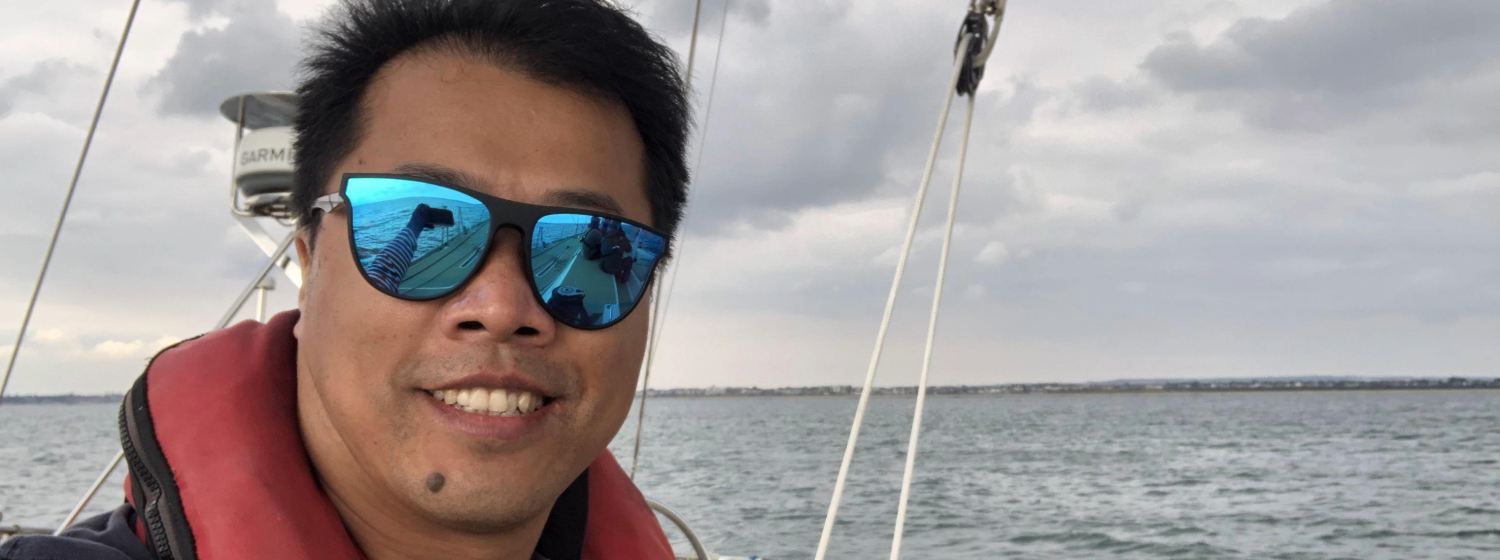
Meet the Clipper Race Officials: Sean Liu
20 March 2024
With the Clipper Race fleet docking in two stops in China, Zhuhai and Qingdao, what better time to introduce Clipper Race’s Liaison in China, Sean Liu. Sean has been a member of the Clipper Race Office for more than twelve years, spanning five race editions, and plays a key role in the Communications, Partnerships and Logistics teams supporting on our relationships in China and the delivery of stopovers.
Tell us about your role with the Clipper Race
My role is to be the day-to-day representative of the Clipper Race, based in Qingdao, China. Part of my job is to help look after our Chinese partners. I also help our Partnerships Team in establishing relationships in China, and help the Communications Team generate more media exposure here and around the world.
What do you love most about the Clipper Race?
The Clipper Race started it all for me in terms of making a career in the sailing industry. I still remember when twelve years ago I got the privilege of working for the Clipper Race as a translator, assisting my UK colleagues in Qingdao whilst looking after the boat build of the Clipper 70s which launched in 2013. These yachts have since sailed around the world four consecutive times and the fleet is now on its fifth loop. Over the years, I have been given opportunities to work on more aspects of the race, such as Partnerships, Communications, Logistics and delivering stopovers, which I have always enjoyed very much.
I also enjoy the travel to other places in and outside of China, but becoming a part of this amazing global adventure, shared by people from all over the world is the bit that excites me the most.
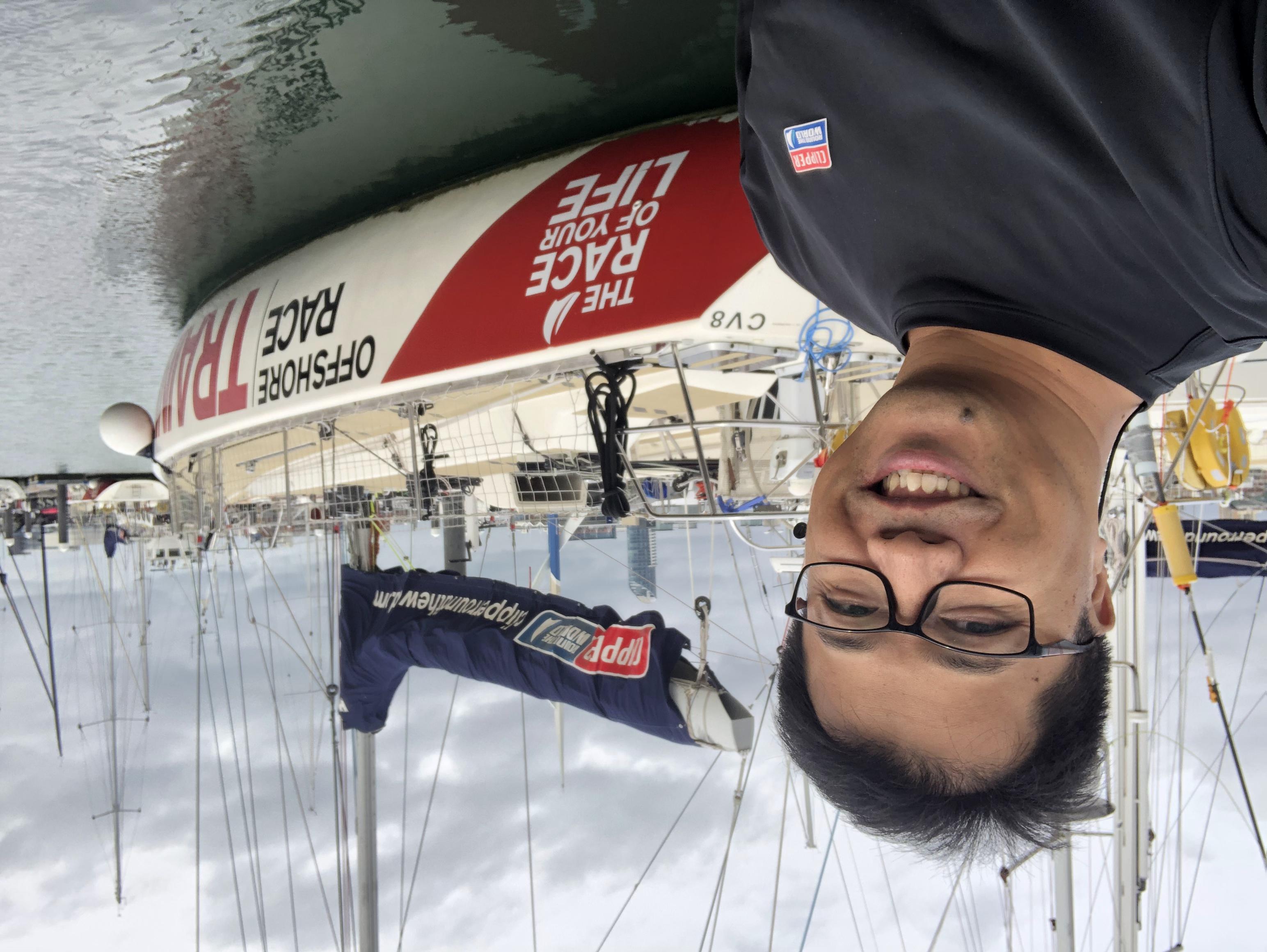
Image: Sean Liu
What’s the best thing about the Clipper Race coming to China?
I’m based in Qingdao. This city is the longest Host Port and Team Partner of the Clipper Race, which is why I think people are so excited about the Clipper Race coming back here. I often hear our partners in Qingdao commenting that the Clipper Race is part of the success story of Qingdao, and vice versa! Qingdao has a longstanding legacy with the Clipper Race since its debut year of partnership in 2005, where Qingdao used the event as a key proponent of its drive to host the Beijing Olympic sailing events in 2008. It makes me feel very proud as this was also a key objective for Qingdao - to put the city on the map as the leading location in China and Asia for international sailing competitions, and the city has proudly hosted a wealth of global sailing events.
The partnership success of Qingdao is inspiring, and more Chinese cities have followed. Sanya joined the Clipper Race family and made history by winning the overall race during their debut show in Clipper 2017-18 Race, and then Zhuhai, a high-end and vibrant city, has joined us for a second time as a Team and Host Port partner.
A key feature of the partnerships with Chinese cities is the Ambassador Programme that has developed the skills of over a hundred Chinese sailors, many of whom have gone on to sail professionally or work in the sailing industry. So, there’s already a robust and solid Clipper Race oriented sailing community based in China.
What’s the welcome going to be like for Clipper Race crew?
Well, it was the first time the Clipper Race fleet sailed into Zhuhai, which was an amazing stopover! Although for the Qingdao stopover, I can say that the welcome ceremony for crew arriving is going to be a blast. It’ll be filled with a lot of joy, and cultural performances with drummers and dancers. There will be some surprises, gifts, and the stopover will be filled with a lot of cultural activities that the crew can experience.
.jpeg)
Image: The infamous Qingdao welcome for the Clipper Race fleet
If you were to sail on the Clipper Race, which leg would you choose?
I think I’d be keen to try the Roaring Forties (Leg 3) or the North Pacific (Leg 6) because they are the longest and most exciting, challenging legs, with cold temperatures and various conditions to experience. I believe that’s a true demonstration of what ocean racing is all about.
What are the best things to eat and drink in Qingdao?
I’ve been living in Qingdao for nearly 20 years, so I’ve found a lot of good places to eat. First, Qingdao is famous for seafood, namely seafood dumplings. Plus, there are a number of bars in the city, both traditional Chinese and Western style. There are too many great places to tell you about!
What are the best things to do in Qingdao?
There are a lot of maritime activities. There are museums, fun parks, tourist attractions such as Zhan Qiao Pier, Zhongshan Pedestrian Street, the old downtown area of the city with a bit of western elements and features, also the amazing light shows on sides of the skyscrapers along the coast of the new downtown area near the Olympic Sailing Center Marina, where our Clipper 70 fleet will be berthed, and so much to do with friends and families.
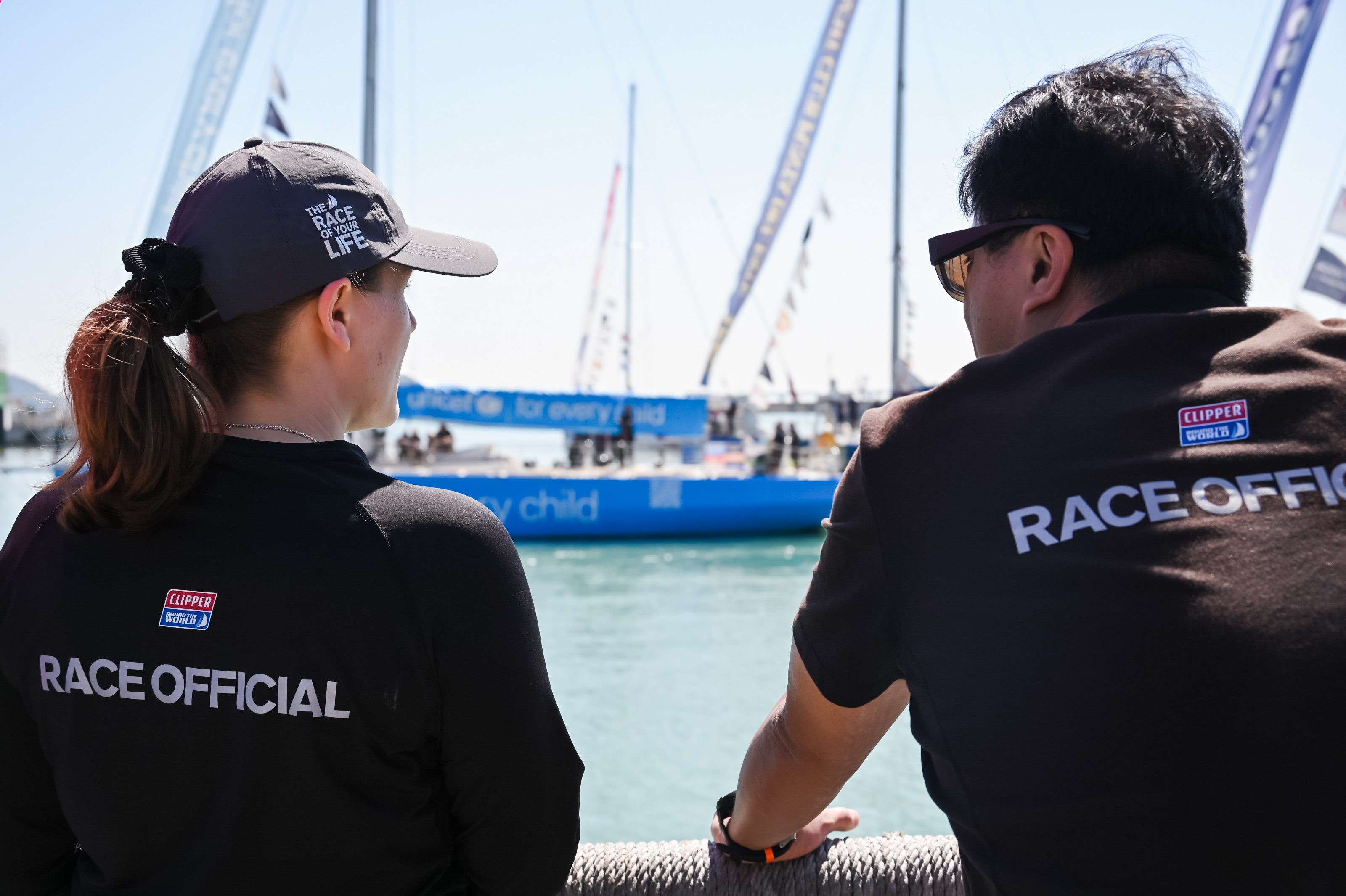
Favourite moment of working on the Clipper Race?
Apart from the time spent on Qingdao stopovers, the best memories of my job are definitely the Clipper Race Start and Race Finish in the UK with my colleagues. This is the fifth race edition I am working on so I’m looking forward to more unforgettable moments to come.
Related Stories
19 Mar 2024
Qingdao ETAs
Please see below the latest ETAs for the fleet's arrival in Qingdao (correct as of 0900UTC on 19/03/24)
12 Mar 2024
Goodbye Zhuhai!
As the fleet departs Zhuhai, the lively departure ceremony saw the marina walls lined with hundreds of spectators, including Jiuzhou Zhuhai officials, Race Crew supporters and newly recruited Clipper Race fans as they waved off teams on the next stage of the circumnavigation. Race 9:…
Race 9: Sailing City-Qingdao Cup gets underway
After a jam-packed stopover in Zhuhai, it’s back to boat life as the fleet focuses on the next race in…
11 Mar 2024
Race Conditions and Skipper thoughts- Race 9: Sailing City – Qingdao Cup
The Zhuhai stopover has drawn to a close, with teams spending time exploring the city and surrounds, and preparing for some tough races ahead. With final briefings now complete, the focus is now fully geared to Race 9: Sailing City – Qingdao Cup.This 9-day race…
Zhuhai Prizegiving
The Zhuhai Prizegiving was long awaited and did not disappoint. A packed banquet hall of Race Crew, supporters, Race Officials…
Welcome to China- Zhuhai receives heroes homecoming!
Race 8: Sprint to the City of a Hundred Islands saw the Zhuhai team proudly sail into its home port…

- CLASSIFIEDS
- NEWSLETTERS
- SUBMIT NEWS
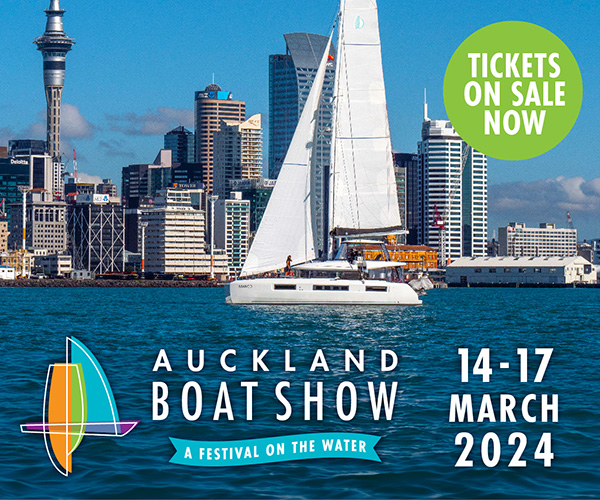
Clipper Round the World Yacht Race set to visit trio of Australian stops in upcoming edition
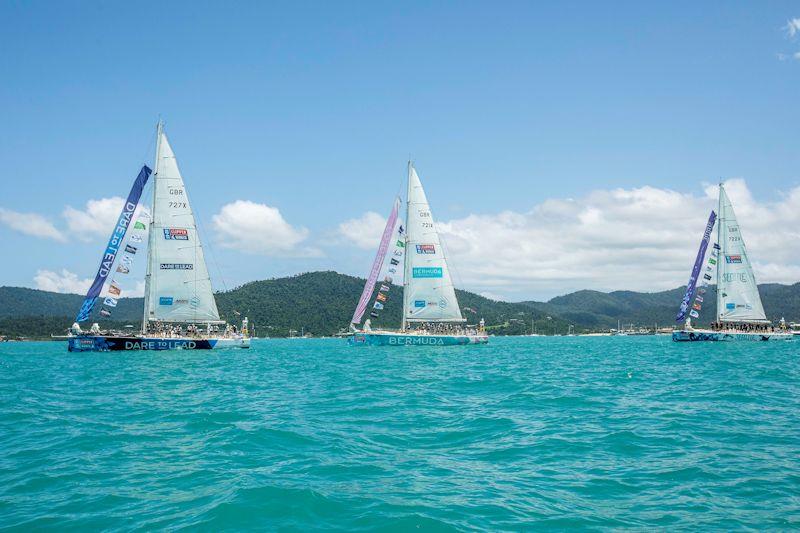
Related Articles
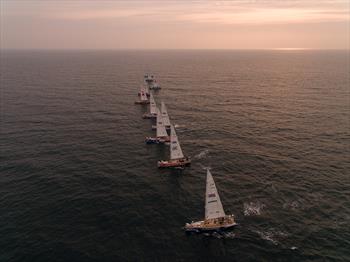
- Administrative Divisions
- Government Officials
- World Connections
- Biz Updates
- Competitive Industries
- Development Zones
- City of Brands
- Attractions
- Transportation
- Travel Agencies
- Accommodation
- Cultural Venues
- Cultural Events
- Sailing City
- Photo Gallery
- West Coast New Area
Home > News
Clipper Race to visit Qingdao for 9th straight time
Eleven Clipper Race boats start their voyage to Qingdao, China's sailing capital, on March 14. [Photo/Qilu News]
The 2023-24 Clipper Round the World Yacht Race (Qingdao) will be held at the Qingdao Olympic Sailing Center in Shandong province from March 21 to 27. After a six-year hiatus, the Clipper Race will make its ninth stop in Qingdao.
The 2023-24 Clipper Round the World Yacht Race set sail from Portsmouth, England on Sept 3, 2023 (local time). This season has attracted 11 teams composed of more than 700 sailors from over 55 countries and regions. The race has an expected duration of 11 months, and participants will visit six continents, eight countries, and 14 ports, covering a total distance of 40,000 nautical miles.
Currently, the race is in the midst of its sixth leg, with the Chinese yacht Qingdao having already secured victory in one leg of the race. Based on the current sailing trajectory, the fleet is expected to arrive in Qingdao around March 21 and depart for Seattle, United States on March 27.
The race is now on its sixth leg, with Chinese yacht Qingdao having already secured victory in one leg. [Photo/Qilu News]
This year marks the third time that Qingdao, known as China's sailing capital, has sponsored a leg of the Clipper Race.
The Chinese yacht Qingdao clipper continues to serve as a global mobile promotional platform, showcasing Qingdao's status as a vibrant marine city. Ten ambassador sailors have been recruited again this season to represent Qingdao. Wang Ziqi and Bu Xuan are currently competing on board the Qingdao and are expected to arrive in Qingdao in one week.
The Clipper Round the World Yacht Race is the world's largest global sailing event, and Qingdao is the first Asian city to host the race.
As China's sailing capital, Qingdao is committed to both hosting high-end sailing events and cultivating and expanding independent brand events, striving to increase the quality and attractiveness of sailing events and become a new sailing hub.
Qingdao's way toward a prosperous and beautiful city
Qingdao, china, government work report receives positive feedback from envoys, video: what is 'two sessions' and why it matters.
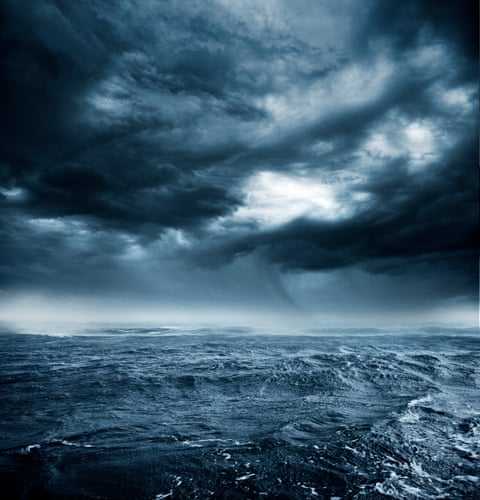
Dark waters: how the adventure of a lifetime turned to tragedy
The Clipper round the world yacht race was created for amateurs seeking the ultimate challenge. But did they underestimate the risks?
O n 18 November 2017, Simon Speirs, 60, a retired lawyer from Bristol, was hauling on his waterproofs below deck on a yacht in rough seas in the Southern Ocean. For nearly three months, he’d endured cold, cramped quarters, soaked clothing, sea sickness and very little sleep. As one of the crews competing in the Clipper Round the World yacht race, Speirs had completed more than 13,000 nautical miles since leaving Britain, but the wild remoteness of the Southern Ocean was more challenging than anything he had experienced before.
Speirs had a hacking cough and a heavy cold, but as leader of the watch he had to get out on deck. The race had so far taken them across the northern Atlantic Ocean to Uruguay and back across the southern Atlantic to South Africa. Two months in, he’d asked for a break. But after only a week his replacement had fallen out of his bunk and hurt his wrist, and Speirs had to resume his role.
By 2pm, the wind was getting stronger; the yacht lurched up and down waves the size of steep hills. The captain ordered the crew to change the headsail to make the boat easier to control. Speirs made his way to the foredeck, but, at that moment, a massive wave hit, sweeping him over the side.
Speirs was still attached to the boat with a tether. For several minutes he was dragged behind the boat in the roiling waves, while the crew tried to haul him back in. Then the clip on his harness snapped, and he lost contact with the yacht. It took three attempts and 32 minutes to pull him back on board, by which time he was dead.
Simon Speirs is exactly the sort of person Robin Knox-Johnston, the veteran sailor, had in mind when he founded the Clipper Round the World yacht race more than 25 years ago. At that time, the only people who got to race boats around the world were professional sailors. Clipper was designed for ordinary people: offering training and the opportunity to join a mixed-ability crew, it would enable customers to achieve the ambition of a lifetime.
The race is held every two years. Eleven yachts, each with a paying crew of 16-22 amateurs, led by a professional skipper and a qualified first mate, start from an English port, and take up to 11 months to cover 40,000 nautical miles. Paying crew can choose to do one or more legs of the journey, and it isn’t cheap. To take part in the whole race, over seven or eight legs, costs around £50,000. The route takes in some of the world’s most treacherous seas, but you don’t need any sailing experience to participate. According to Clipper Ventures, the company that runs the race, around 40% of participants are complete novices. Since it began, the race has become hugely popular.
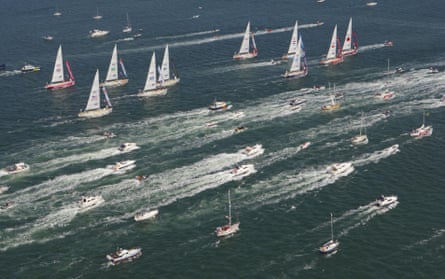
Clipper Ventures is not the first outfit to sell an iconic and dangerous challenge to amateurs. On 23 May 2019, 354 climbers made it to the top of Mount Everest in a single day . This included a dentist, an architect, a surgeon, a CEO and a housewife, who had each paid between £33,000 and £100,000. The oldest was 64. The commercialisation of extreme adventure has been made possible by advances in technical equipment like satnav and portable oxygen metres, and turbocharged by a hunger for personal growth and fulfilment. But it has also been accompanied by accidents and tragedies. May 2019 was one of the deadliest seasons on record: 11 climbers died on Everest in nine days . According to reports, overcrowding and underprepared climbers were partly to blame.
There have been other fatal accidents on the Clipper race, too. On 4 September 2015, Andrew Ashman , 49, a paramedic from Orpington, south-east London, was standing in a known danger zone in the yacht’s cockpit area when he was struck by the boom and suffered a fatal neck injury. Six months later, on the same boat, Sarah Young , 40, an entrepreneur from London with no previous sailing experience, died after being swept overboard by a wave. She was not clipped on.
According to a report by the Marine Accident Investigation Branch (MAIB) into Speirs’s death, published in June 2019, 17 people fell overboard from Clipper yachts between 2013 and 2018. Just over two weeks before Speirs went overboard, a Clipper yacht ran aground and had to be abandoned in a “very serious” incident just off the coast of South Africa. An MAIB investigation into that incident published in June 2018 concluded that the inexperience of the crew was a factor: “With only one professional, employed seafarer on board, the Clipper yachts were not safely manned for the round the world race.”
“If you read Clipper’s material, you’d think their number one concern was to keep people safe, but they have failed in so many ways,” said Margaret Speirs, Simon’s widow, when we first met in 2020. “I believe the company is compromised by their desire to make money out of these races.”
Knox-Johnston has strongly denied such claims. “Safety is a core principle of the Clipper Race, ahead of the racing element of the event itself, and therefore the most important part of the training of its crew,” Clipper Ventures said in a statement to the Guardian. The company says it has made investments in safety gear, becoming “the first ocean-racing company to introduce personal AIS beacons into its lifejackets to aid recovery of a man overboard”.
After the deaths of Ashman and Young in the 2015-16 race, the future of Clipper looked uncertain, a source who works at Clipper Ventures told me. “I thought, nobody is going to want to sign up.” But, in fact, applications increased. People are drawn by the chance to do something exceptional – and the risk is part of the attraction. Many customers, the source said, tend to think: “This is really dangerous! This is something I’ve got to do!”
T he founder of Clipper Ventures, Knox-Johnston, became the first person to sail solo around the world , without stopping, in 1969. In the memoir he published soon after his return, he describes the hardships he endured. His boat leaks, his water supply gets polluted, his steering gear is smashed, he shoots a shark when it comes too close, and suffers what was later diagnosed as a burst appendix. He carries on, undaunted. This, it seems, is the Knox-Johnston way. At the age of 68, he became the oldest person to race solo around the world. He had got irritated with people saying he was past it.
In the autumn of 1995, the same year he received a knighthood, Knox-Johnston placed newspaper ads to see how many people would be willing to pay to become part of a round-the-world crew. The response suggested that there may be a viable business in the idea. William Ward, a former property developer, who became CEO of Clipper Ventures, invested £1.8m.
Knox-Johnston commissioned eight new boats – Bluewater 58 sloops – from Colvic, a shipyard near Chelmsford, Essex. The company set up a base in Plymouth, Devon, and Knox-Johnston recruited friends from the sailing world, many ex-servicemen, as skippers. As soon as the boats were completed, they began training crew, taking on additional skippers as they went.
On 16 October 1996, the first race left Plymouth with the eight boats. The race was a success, and over the next few years Clipper built itself into an international brand. Major companies started to sponsor the boats (Garmin, Nasdaq), as did charities such as Unicef, and, from 2002, British cities such as Leeds, Liverpool and Glasgow. “Since the first race in 1996, the event has been transformed from a low-key amateur sailing race into a major, and highly profitable, international event attracting the interest of the world’s media and business leaders,” wrote Ward in Clipper company accounts in 2007. In the following years, the company continued to grow.
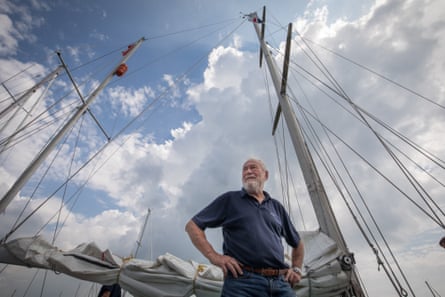
After the 2011-12 race, the company upgraded its yachts, and launched the new Clipper 70s, manufactured in China. They were longer and faster than the previous yachts, reflecting Clipper’s ambitions for more exciting racing. In 2018, Clipper expanded its business to Asia with the launch of a China-based division, Clipper China. In 2019, the company made a profit of £3.2m; by 2020 it had a staff of 86.
The man at the heart of this success, Knox-Johnston, is, in the words of the Daily Mail , “a patriotic Englishman of the old school”, who “embodies the spirit of the stiff upper lip”. He has little time for what he sees as unnecessary bureaucracy. In his autobiography, he criticised the Maritime and Coastguard Agency (MCA), the government department that enforces safety at sea and sets standards for the Clipper race. Knox-Johnston complained about its ridiculous and “inappropriate” rules for small racing yachts.
Knox-Johnston sees the race as a life-changing opportunity. Ben Bowley, a skipper and chief instructor, who worked for Clipper Ventures for nine years from 2011, was impressed by Knox-Johnston’s vision and belief. “He has drive, passion and his ability to convey the awesomeness [of the race] is quite captivating.” Having completed the race, Knox-Johnston wrote in his autobiography, people “usually feel confident to take on greater challenges”. He continued: “They have painted their lives with bright colours, not pastel shades, and that brightness is like a drug and they want more of it.”
T he moment Simon Speirs decided he was going to sail around the world came in 1992, when he was in his mid-30s. Watching the first TV footage of the Whitbread Round the World race, he was entranced by the huge seas of the Southern Ocean. “It then became more a case of ‘when’ rather than ‘if’,” he later wrote on his blog. Ocean sailing was his wife’s idea of misery, but she understood his obsession. “Simon was excited about it. It was his retirement dream to do it before he was too old, too infirm,” she said.
Speirs, a senior partner in a Bristol legal firm, was meticulous and thorough. He liked to-do lists and DIY, and had a dry sense of humour. He also had an adventurous side. Every two years he would take on a challenge to raise money for charity: he had climbed the Three Peaks (the highest mountains of Scotland, England and Wales), cycled from Land’s End to John O’Groats, run a 66-mile race in the Lake District.
Speirs originally signed up for the 2015-16 race. But he deferred his place because work was busy and his oldest son was getting married. Better to wait until the next race, 2017-18, when he would be 60 and newly retired. He kept fit by cycling six miles a day to work.
Speirs was a keen amateur sailor. He kept a couple of dinghies on a reservoir in Chew Valley, Somerset, where he had “sailing Sundays” with his children. He had a son and a daughter with his first wife, who died in 1991, and two sons with Margaret, whom he married in 1996. He had skippered chartered yachts on family holidays in the Mediterranean. “But that in no way compares with the experience of these huge racing yachts in these wild oceans,” said Margaret.
Training for the Clipper race consists of four courses, levels 1-4, each lasting a week. This process, which is compulsory for participants, covers basic sailing techniques – headsail changes, tacking, gybing, helming; as well as race strategy and safety. Trainee crew also sail offshore, mostly in the Solent, and later spend a few nights in the Channel. “The Solent and the Channel are widely recognised as one of the best sailing grounds in the world for training,” said a spokesperson for Clipper Ventures, because “of the complexity of tides, shipping, navigational hazards and inclement weather”.
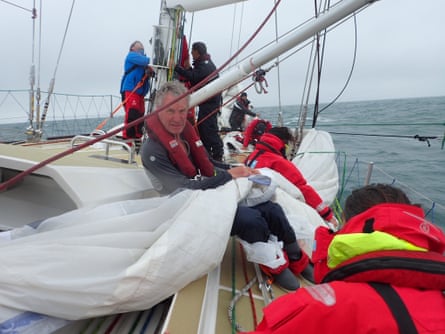
The people who sign up for the Clipper race tend to be middle-aged men of means. Many are at a turning point in their lives: just divorced, promoted, retired, bereaved, recovering from illness. Nathan Harrow, then 43, a business consultant, decided to sign up as a round-the-worlder in the 2017-18 race after a period of stress and depression after redundancy. “Clipper was me drawing a line under the old me and getting my confidence back,” he told me.
Mary Morrison, a mentor for troubled children, from south-west London, was 65 and perfectly content with her life, when she did the 2015-16 race. “One of the guys I was sailing with said, ‘You’re the one least after change, but you’ll probably change the most’, and that was probably true,” she says. She gained new friends, an appreciation of the scale and sheer beauty of our planet, and a sense of how we need to look after it more. “And it gave me a lot of confidence,” she said. Another woman in her 60s, who did the third leg of the 2017-18 race, told me it was the best thing she had ever done.
Crew are assigned to each yacht a few weeks before the race. The aim is to balance experience and ability across the fleet. Whether everyone gets on is a matter of pure chance. “It’s one big social experiment,” said a crew member who did the race in 2007-8 and again in 2017-18. “If you’re lucky, you have a good time. It’s partly to do with the characters involved.”
Each boat is certified for 24 people including one skipper, who in 2017 was paid about £38,000 a year, plus £150 a day for six months of training beforehand. (“We ensure that our skippers share Clipper Ventures’ ethos of safety above all else,” said Clipper Ventures. “Anyone who fails safety standards is dismissed.”)
For many years, Clipper were required to have two professional sailors on board during the race, under the MCA’s small commercial vessel code. However, a freedom of information request shows that in 2010, Knox-Johnston lobbied the MCA to allow him to replace the second qualified person with a trained-up member of the fee-paying crew. The MCA refused. In 2012, with the MCA under new leadership, Knox-Johnston tried again. “We have tried to make the system of having two qualified people aboard each boat work,” he said in a meeting with the MCA on 1 August, but, he said, it is “not financially sustainable”.
Knox-Johnston had a subsequent meeting with the MCA at Clipper’s base in Gosport, Hampshire, at the end of September. Details of the meeting were not released. A year later, in October 2013, the MCA granted Knox-Johnston’s wish. From that point on, it wouldn’t be necessary to have two professionals on board. All that was required was one fully qualified skipper, and a second person who had successfully completed the company’s coxswain training course.
The Clipper coxswain’s course lasts 12 days, and is paid for by Clipper. The company aims to have two people on each boat who have taken the course, which covers use of radar, reading wind direction and force from a chart, calculating tidal flow and ocean currents, and manoeuvring the yacht safely into a berth in a port or harbour. Some sources I spoke to were sceptical about whether this training is really a match for hands-on experience. “As a professional sailor you’re trained to look and see things that are going wrong ahead of catastrophe,” said one skipper. “You’ve got to have this ability to stand back and look at the whole picture, all the time.”
After the deaths of Ashman and Young in the 2015-16 race, the MAIB urged Clipper to review its manning policy. “The special nature of the Clipper Round the World yacht race places a huge responsibility on one person to ensure the safety of the yacht and its crew at all times,” the MAIB wrote in April 2017.
Four months later, the 2017-18 race started without a second paid professional on board any of the boats.
T he race was not quite what Speirs had imagined. Seven weeks in, he described the trip on his blog as “acute discomfort mingled with elation and awe”. High points included the “beauty of the sky at night”, the “soft swish” of the boat through calm sea, the camaraderie of the crew and an encounter with a pod of dolphins. Less enjoyable was the sea sickness, the cold and the lack of sleep. Speirs had dropped two trouser sizes since the start of the race, a fact he attributed to the physical effort of sailing. Pulling ropes. Grinding winches. “I miss you very much,” he wrote in a letter to Margaret, on 10 October. The experience, he said, was “not a barrel of laughs”. But he still planned to complete all eight stages. “I am too stubborn to drop out,” he wrote on his blog.
Not all of his fellow crew members were so reluctant to quit. Mark Tucker, then 40, had signed up to do the whole Clipper 2017-18 race and was assigned to Great Britain, the same boat as Speirs. (The boat was sponsored by the British government, as part of a marketing campaign to attract tourism and investment; on 2 August, the crew were photographed outside 10 Downing Street .) However, Tucker left after the first leg because of his concerns about safety. He felt that there was insufficient time before the start of the race for maintenance and repairs to the boat. At the time, he wrote a resignation letter to skipper Andy Burns, explaining his thinking, but he wasn’t able to speak candidly in public because he’d signed an NDA. “In retrospect,” Tucker told me, “I view them very much as a media/PR company that happens to do a bit of sailing, rather than the other way around.”
By the end of the second leg, Speirs was exhausted. At the end of the 10-day stopover in Cape Town, South Africa, he wrote on his blog that he had used the layover to “repair and recharge”. He went to bed early and ate healthily. He got his haircut and met up with his daughter, Katherine, and her husband. She gave him a fruit cake baked by her mother-in-law.
On 31 October 2017, the Clipper boats began the third leg of the race: Cape Town to Fremantle, Australia. A journey of more than 4,700 nautical miles, it would take about 23 days and pass through the Southern Ocean, one of the world’s most dangerous waters. An area of almost constant high wind and frequent gales, it is where one of the highest ever waves was recorded – 120 feet.
For this third leg, the crew had dropped from 20 at the start of the race to 16. The average age was 50, but the overall sailing experience was greater than on the previous two legs. Tim Jeffery, then 56, an architect from London who had sailed small boats for 15 years, had signed up for the first leg “to get to know people”, and the third leg for the Southern Ocean. “It is the most remote place in the world,” he told me. “The sea is dramatic. It’s challenging because of the size of the waves. You also get very fast sailing and it’s hard work.”
The crew was divided into two groups operating a system of five watches a day: two shifts of six hours from 8am; three shifts of four hours from 8pm. Everyone was given a job: engineer, medic, treasurer. As well as head of his watch, Speirs was the nominated sail repairer. He became known as “Tailor of Gloucester” on account of the hours he spent at the sewing machine with glasses perched on the end of his nose.
Speirs was also the Clipper coxswain, regarded as the skipper’s second in command. Great Britain had actually started the race with three paying crew members who had completed the Clipper coxwain’s course: one was Tucker; the other, apart from Speirs, was Jon Milne, then 50, an IT director, who was injured at the time of Speirs’s accident. A common theme of Speirs’s blog was that he felt overworked.
Everyone on Great Britain was delighted with their captain, Andy Burns. Then 31, Burns had started sailing as a schoolboy in Lincolnshire. After working on superyachts and for the Royal National Lifeboat Institution, he joined Clipper Ventures as an instructor in 2015. This was his first race as skipper.
Speirs regarded Burns as an ally. Both were good with people, patient, enthusiastic. Burns prioritised safety over speed. He “assessed the abilities and limitations of his crew to the extent that, during leg two, he made the decision not to race competitively, but to sail conservatively”, according to the June 2019 MAIB report.
Once the boat was sailing through the Southern Ocean in extremely cold weather, the shortage of experienced hands became a problem. Speirs wasn’t able to rest as there was no one to take his place. “The boats are set up for a certain number of crew,” according to a source at Clipper Ventures. “You need that many people to be able to work the boat. If you’re one or two people down that’s very problematic, and of course it makes the rest of the crew tired.”
After the 2014-15 race, a fitness test became part of the interview. Crew have to show they can climb on to a top bunk (not so easy when the boat is listing at 45 degrees) and get on the boat without using a ladder. The source said they felt Clipper Ventures’ vetting process needed to be tougher. Being at sea can be petrifying. “People become frozen with fear and start behaving out of character and become very difficult because they’re frightened.”
One person, who did not want to give his name, signed up for leg three on Great Britain in the 2017-18 race. In the final week of training, the boats raced down to France and back. “The weather was hideous. We had 18 people on board and there was probably only four or five of us that managed to keep the boat sailing. The rest were incapacitated downstairs. I was burning myself out covering for other people. When we pulled up into the dock, I packed my bags and I said, I’m done, it’s not safe.”
The dropout rate among round-the-worlders is 40%, wrote Speirs on his blog. Things must get very bad, because crew are liable for 100% of the fees if they drop out during the race. “People remortgage homes and invest significant amounts of money in the adventure,” said one former crew member. “Sometimes as much as £100k if you include insurance, food, accommodation, flights, kit etc. It’s going to take something pretty serious to knock them off course.”
A part from injuries and fatigue among the crew of Great Britain, a major concern was the condition of the boat. In an email to Clipper’s management on 3 July 2017, six weeks before the start of the race, Speirs had pointed out that Great Britain was leaking. “Still working hard to keep water out. Not easy job and pretty hairy when boat kicking around. This should have been sorted out at refit before handover. It’s a safety issue,” Speirs wrote in his blog on 12 August.
The boat was still leaking when it left Liverpool on 20 August 2017. Within two days the generator packed up. The water maker, which turns salt water into drinking water, didn’t work for three weeks. “Andy [Burns, the captain] was spending his entire time dealing with maintenance issues on a boat that was three weeks into a year-long circumnavigation,” said Mark Tucker. “If he’s down below sorting out why the water maker doesn’t work or the generator doesn’t work, he’s not on deck coaching people, making sure the boat’s being sailed safely.”
As part of its investigation, MAIB singled out an issue with the guardrail and supporting stanchions, which may have been partly responsible for Speirs’s death. The guardrail, which was designed to keep crew from falling overboard, was damaged in rough seas on 4 November, 13 days before Speirs’s accident. The crew managed to lash up the guardrail by wrapping rope around it. “The repair was not great,” said Tim Jeffery. “We had to be extra careful on the foredeck after that.”
The MAIB report identified a series of problems with Great Britain. “The cumulative effect of the defects was to increase workload for the crew, contributing to their fatigue, lowering morale, and distracting from sailing and gaining sailing experience,” it stated.
There were problems on other boats. Unicef had to be bailed out every four hours, on legs one and two, according to one round-the-world sailor. Unicef started the race with a broken fuel pump. The generator failed on the first leg. Two crew members who had signed up to do the whole race left Unicef after leg two, saying they were unhappy with the number of problems with the boat that needed attention.
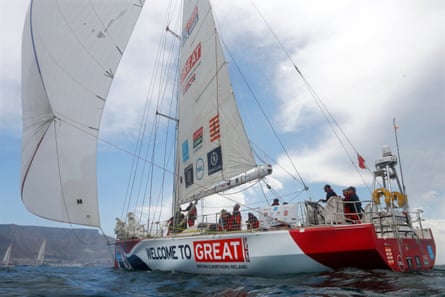
Staff at Clipper put the malfunctions down to normal wear and tear. The boats had been around the world twice at that point, they say, as well as being used in training and for corporate events. “Some people believe that because they are paying to go around the world, the boat should be like hiring a car,” said Lance Shepherd, skipper on Liverpool during the 2017-18 race. “Everything should be immaculate, ready to go. But that is not how boats work. They are much more fickle and difficult to maintain.” Clipper’s management was prudent, he said. “They put safety first and foremost.” The boats “get stripped right back and overhauled” at the end of every race.
But there were also problems with the Clipper 70s from the outset. Clipper Ventures first discovered an issue in 2013, when the new hulls were shipped to the UK from China. There were gaps in the layers of fibreglass-type material, which could “make the boat more prone to cracks in extreme seas”, a marine surveyor told me.
Clipper had the entire fleet surveyed in February and March 2013. They had the “bad parts” cut out of the new boats and relaminated, according to Knox-Johnston. Not an easy job, given the scale of the problem, or the time frame in which repairs had to be done. The 2013-14 race was due to start in just over six months’ time. It couldn’t be delayed. Sponsors were signed up, the jamboree of corporate backers, supporters and families was already planned in each port.
Crew members later expressed concerns that there were too many problems to fix in the short time before departure. Garmin crew member Kira Pecherska, an experienced and highly qualified sailor, said there was no time for proper sea trials. “If you send a boat on a transatlantic journey, especially with beginners on board, who have no experience in sailing at all, at least these boats must be trusted. And you can only trust your boat when you test it.” (Clipper Ventures said: “Clipper Race yachts are well built, well tested and maintained by a dedicated and highly skilled maintenance team who travel to every port of call on the race route.”)
The source who works at Clipper Ventures told me there was anxiety about reporting problems: “There is a fear culture, that prevents a lot of that. They [skippers] are thinking, I’m going to get crucified for letting that happen.”
According to Clipper Ventures, on stopovers Knox-Johnston and Ward have “been accessible to all sailing staff and crew for any questions or concerns. They created a culture of openness and this continues with all Clipper Ventures staff today.”
A t about 2pm on 18 November 2017, Simon Speirs came up on deck, wearing a foul-weather jacket and salopettes. Conditions were rough: his fellow sailors had never seen such massive seas. His wedding ring was tied around his neck on a leather shoelace: jewellery was considered a safety hazard on board. He was one of five crew on the foredeck lowering the headsail. He was attached to the deck with a safety tether.
At 2.14pm, Great Britain was hit by a huge wave. The yacht dropped into a trough, slewed violently, and Speirs was thrown into the water. One crew member, who did not want to be named, saw Speirs with his lifejacket inflated, being dragged alongside the boat. He leaned over to try to grab him, but Speirs was just out of reach. He tried pulling on the tether, but the boat was going too fast. He could see Speirs was struggling as the water buffeted him. “He was constantly being hit by the waves. Never able to gather his breath.”
The crew member managed to hand Speirs a rope with a lifting hook to attach to his lifejacket, in order to winch him out of the water. Speirs tried to clip the rope to his lifejacket, but he was getting exhausted. “Water was going over his face and he was being bashed against the side of the boat.” As Speirs was dragged through the sea, his clip bent out of shape. At 2.22pm, it snapped open.
“My immediate thought was, thank God, he’s not going to drown by being dragged along by this boat,” said the crew member. “We can get the boat under control and go back and get him. We’ll get him in two minutes. It’s not dark. It will be fine.” But turning the boat around in strong wind and very rough seas was not easy. It took three attempts to retrieve Speirs from the sea. Finally, at 2.54pm, 40 minutes after he fell in the water, six crew lifted Speirs on board Great Britain. His lifejacket was cut off and crew carefully carried him below deck. He was already dead.
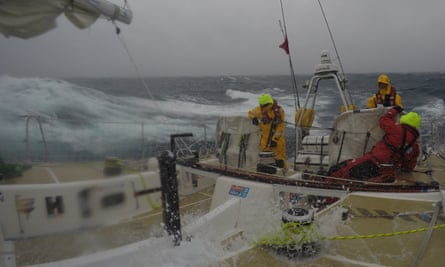
After Speirs’s body was brought aboard, the skipper radioed to the Australian coastguard. Clipper tried to contact Margaret, but when they couldn’t get through they called the family home and broke the news to their son Toby. “They told him his father had died,” said Margaret. “A 17-year-old lad who is on his own at home. Toby is a sensible lad but I’m sure it has scarred him for life. Clipper did wrong by us, very wrong by us.”
“We tried to contact Mrs Speirs, Simon’s emergency contact. Unfortunately she was not at home and her mobile phone was switched off,” said Jeremy Knight, then chief operating officer at Clipper Ventures, in an email to the crew of Great Britain, after being informed that the Guardian was investigating Speirs’s death. “This decision to break the news to Simon’s son has proved difficult for the family, and we understand that,” Knight wrote. “But the alternative, holding off and risking the family finding out through the media, was much worse.”
At 7pm that evening, the race director called Margaret and told her that her husband would be buried at sea in eight hours. “He was not giving me any options. He told me they had come to that decision for the benefit of the crew so that they wouldn’t have to travel with Simon’s body on board. And they told me the burial at sea would be at three o’clock in the morning our time. And by three o’clock in the morning we did have some friends and family gathered. The vicar came and we read the service at home that they were having in the Southern Ocean as if we were sharing it.
“The burial at sea has robbed me and my family of the opportunity of laying Simon to rest at a place of our choice and allowing us to say goodbye to him in a way that we would have wished to,” she continued. “It has also deprived our family of the opportunity for a coroner’s inquest. We didn’t get a chance to put questions, hear the responses, to help us understand what happened.”
Burns quit Clipper Ventures at the end of leg four. “Andy didn’t enjoy a second on that boat after Simon died,” said the crew member who had tried to rescue Speirs. Jeffery didn’t do the final leg, as planned. After Speirs’s death, he did not feel right leaving his wife and two daughters.
After Speirs’s death, the MCA would not allow the Clipper boats to sail with only one professional onboard. Clipper Ventures had to recruit a second qualified mate for each boat in the fleet for the rest of the 2017-18 race.
The MCA investigation into the death of Simon Speirs was closed in 2020. “The MCA received strong legal advice that the evidence was not enough to bring a prosecution,” stated a spokesperson. The MCA referred the case to Hampshire police to follow up an allegation of fraud in the certification of the boats, and they concluded that there were no grounds to pursue an investigation.
Ward was awarded an OBE in 2018 for his services to the economy and to the Great Britain marketing campaign. Knight retired from his role as COO of Clipper Ventures in April 2022 and is currently a magistrate. When we contacted Knox-Johnston in November 2022, he was at sea.
One bright morning last month I spoke to Speirs’s sons Mike and Toby on Zoom. For more than two years, the family had been fighting a civil action against Clipper Ventures, charging the company with an “immature safety culture”. They wanted to make Clipper Ventures answer for some of the failings that had led to their father’s death. “If you offer a service that is dangerous you have a responsibility to make it as safe as is reasonably possible and I don’t think that was done,” said Toby.
At the end of February, Clipper Ventures paid the family the net sum of £140,000 to settle the case. The family believe the timing of the settlement was no accident. Clipper Ventures is up for sale. In settling the case, the company admitted no wrongdoing. But the family felt vindicated. They donated the money to the RNLI.
Nothing can make up for the loss of their father. Toby is a student at his father’s alma mater, Queens’ College, Cambridge. “I just wish I could talk to Dad about that,” he said. Mike longs to tell his father about the grandchildren he never knew.
For Margaret, the settlement has brought a sense of relief. “I can hang up my sword and put all things to do with Clipper Ventures behind me,” she told me recently in an email. Simon Speirs had always been a loving husband and father. Now they could once again remember him not just by the way he died, but as the remarkable man he was.
This article was amended on 11 May 2023 to correctly refer to the Solent, rather than the “River Solent”.
- The long read
Most viewed
Things to Do in Elektrostal, Russia - Elektrostal Attractions
Things to do in elektrostal.
- 5.0 of 5 bubbles
- 4.0 of 5 bubbles & up
- Good for a Rainy Day
- Good for Kids
- Good for Big Groups
- Adventurous
- Budget-friendly
- Hidden Gems
- Good for Couples
- Honeymoon spot
- Good for Adrenaline Seekers
- Things to do ranked using Tripadvisor data including reviews, ratings, photos, and popularity.

1. Electrostal History and Art Museum

2. Statue of Lenin

3. Park of Culture and Leisure
4. museum and exhibition center.

5. Museum of Labor Glory

7. Galereya Kino
8. viki cinema, 9. smokygrove.
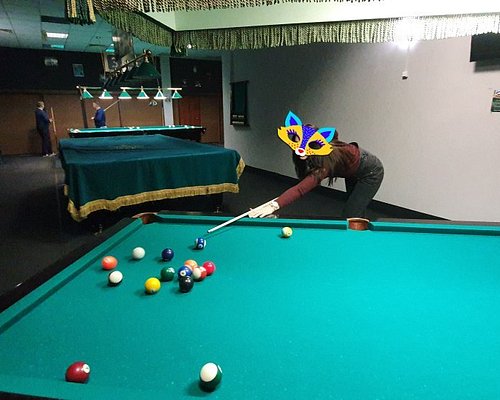
10. Gandikap
11. papa lounge bar, 12. karaoke bar.
- Statue of Lenin
- Electrostal History and Art Museum
- Park of Culture and Leisure
- Museum and Exhibition Center
- Museum of Labor Glory

- New comments
- Military Photos
- Russian Military
- Anti-Aircraft
- SA-21/S-400 Triumf

92N6E Radar, S-400
- Oct 18, 2010
Media information
Share this media.
- This site uses cookies to help personalise content, tailor your experience and to keep you logged in if you register. By continuing to use this site, you are consenting to our use of cookies. Accept Learn more…

Turn Your Curiosity Into Discovery
Latest facts.

How To Protect Children From Junk Food Marketing

12 Intriguing Facts About Balatro
40 facts about elektrostal.
Written by Lanette Mayes
Modified & Updated: 02 Mar 2024
Reviewed by Jessica Corbett
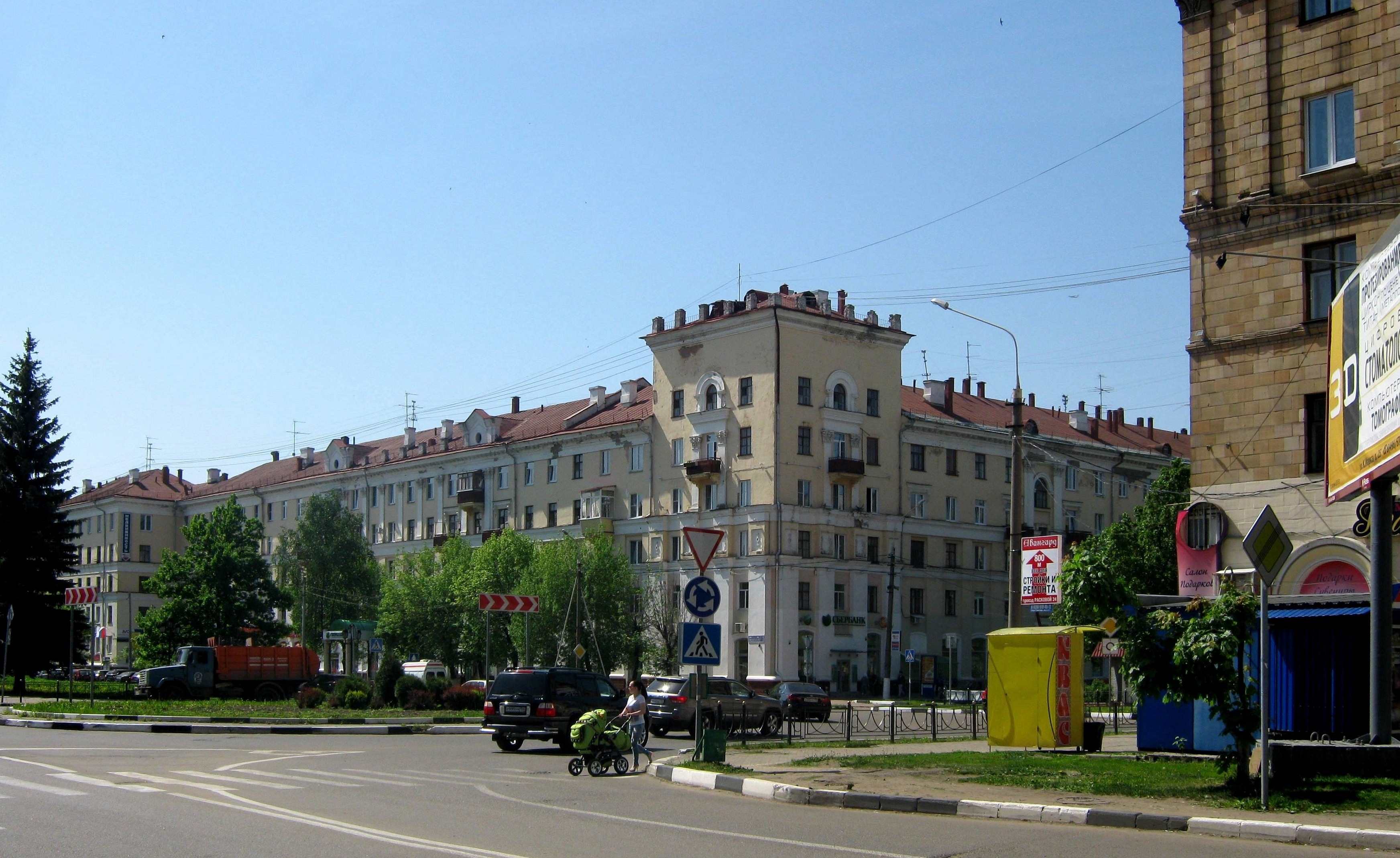
Elektrostal is a vibrant city located in the Moscow Oblast region of Russia. With a rich history, stunning architecture, and a thriving community, Elektrostal is a city that has much to offer. Whether you are a history buff, nature enthusiast, or simply curious about different cultures, Elektrostal is sure to captivate you.
This article will provide you with 40 fascinating facts about Elektrostal, giving you a better understanding of why this city is worth exploring. From its origins as an industrial hub to its modern-day charm, we will delve into the various aspects that make Elektrostal a unique and must-visit destination.
So, join us as we uncover the hidden treasures of Elektrostal and discover what makes this city a true gem in the heart of Russia.

Key Takeaways:
- Elektrostal, known as the “Motor City of Russia,” is a vibrant and growing city with a rich industrial history, offering diverse cultural experiences and a strong commitment to environmental sustainability.
- With its convenient location near Moscow, Elektrostal provides a picturesque landscape, vibrant nightlife, and a range of recreational activities, making it an ideal destination for residents and visitors alike.
Known as the “Motor City of Russia.”
Elektrostal, a city located in the Moscow Oblast region of Russia, earned the nickname “Motor City” due to its significant involvement in the automotive industry.
Home to the Elektrostal Metallurgical Plant.
Elektrostal is renowned for its metallurgical plant, which has been producing high-quality steel and alloys since its establishment in 1916.
Boasts a rich industrial heritage.
Elektrostal has a long history of industrial development, contributing to the growth and progress of the region.
Founded in 1916.
The city of Elektrostal was founded in 1916 as a result of the construction of the Elektrostal Metallurgical Plant.
Located approximately 50 kilometers east of Moscow.
Elektrostal is situated in close proximity to the Russian capital, making it easily accessible for both residents and visitors.
Known for its vibrant cultural scene.
Elektrostal is home to several cultural institutions, including museums, theaters, and art galleries that showcase the city’s rich artistic heritage.
A popular destination for nature lovers.
Surrounded by picturesque landscapes and forests, Elektrostal offers ample opportunities for outdoor activities such as hiking, camping, and birdwatching.
Hosts the annual Elektrostal City Day celebrations.
Every year, Elektrostal organizes festive events and activities to celebrate its founding, bringing together residents and visitors in a spirit of unity and joy.
Has a population of approximately 160,000 people.
Elektrostal is home to a diverse and vibrant community of around 160,000 residents, contributing to its dynamic atmosphere.
Boasts excellent education facilities.
The city is known for its well-established educational institutions, providing quality education to students of all ages.
A center for scientific research and innovation.
Elektrostal serves as an important hub for scientific research, particularly in the fields of metallurgy, materials science, and engineering.
Surrounded by picturesque lakes.
The city is blessed with numerous beautiful lakes, offering scenic views and recreational opportunities for locals and visitors alike.
Well-connected transportation system.
Elektrostal benefits from an efficient transportation network, including highways, railways, and public transportation options, ensuring convenient travel within and beyond the city.
Famous for its traditional Russian cuisine.
Food enthusiasts can indulge in authentic Russian dishes at numerous restaurants and cafes scattered throughout Elektrostal.
Home to notable architectural landmarks.
Elektrostal boasts impressive architecture, including the Church of the Transfiguration of the Lord and the Elektrostal Palace of Culture.
Offers a wide range of recreational facilities.
Residents and visitors can enjoy various recreational activities, such as sports complexes, swimming pools, and fitness centers, enhancing the overall quality of life.
Provides a high standard of healthcare.
Elektrostal is equipped with modern medical facilities, ensuring residents have access to quality healthcare services.
Home to the Elektrostal History Museum.
The Elektrostal History Museum showcases the city’s fascinating past through exhibitions and displays.
A hub for sports enthusiasts.
Elektrostal is passionate about sports, with numerous stadiums, arenas, and sports clubs offering opportunities for athletes and spectators.
Celebrates diverse cultural festivals.
Throughout the year, Elektrostal hosts a variety of cultural festivals, celebrating different ethnicities, traditions, and art forms.
Electric power played a significant role in its early development.
Elektrostal owes its name and initial growth to the establishment of electric power stations and the utilization of electricity in the industrial sector.
Boasts a thriving economy.
The city’s strong industrial base, coupled with its strategic location near Moscow, has contributed to Elektrostal’s prosperous economic status.
Houses the Elektrostal Drama Theater.
The Elektrostal Drama Theater is a cultural centerpiece, attracting theater enthusiasts from far and wide.
Popular destination for winter sports.
Elektrostal’s proximity to ski resorts and winter sport facilities makes it a favorite destination for skiing, snowboarding, and other winter activities.
Promotes environmental sustainability.
Elektrostal prioritizes environmental protection and sustainability, implementing initiatives to reduce pollution and preserve natural resources.
Home to renowned educational institutions.
Elektrostal is known for its prestigious schools and universities, offering a wide range of academic programs to students.
Committed to cultural preservation.
The city values its cultural heritage and takes active steps to preserve and promote traditional customs, crafts, and arts.
Hosts an annual International Film Festival.
The Elektrostal International Film Festival attracts filmmakers and cinema enthusiasts from around the world, showcasing a diverse range of films.
Encourages entrepreneurship and innovation.
Elektrostal supports aspiring entrepreneurs and fosters a culture of innovation, providing opportunities for startups and business development.
Offers a range of housing options.
Elektrostal provides diverse housing options, including apartments, houses, and residential complexes, catering to different lifestyles and budgets.
Home to notable sports teams.
Elektrostal is proud of its sports legacy, with several successful sports teams competing at regional and national levels.
Boasts a vibrant nightlife scene.
Residents and visitors can enjoy a lively nightlife in Elektrostal, with numerous bars, clubs, and entertainment venues.
Promotes cultural exchange and international relations.
Elektrostal actively engages in international partnerships, cultural exchanges, and diplomatic collaborations to foster global connections.
Surrounded by beautiful nature reserves.
Nearby nature reserves, such as the Barybino Forest and Luchinskoye Lake, offer opportunities for nature enthusiasts to explore and appreciate the region’s biodiversity.
Commemorates historical events.
The city pays tribute to significant historical events through memorials, monuments, and exhibitions, ensuring the preservation of collective memory.
Promotes sports and youth development.
Elektrostal invests in sports infrastructure and programs to encourage youth participation, health, and physical fitness.
Hosts annual cultural and artistic festivals.
Throughout the year, Elektrostal celebrates its cultural diversity through festivals dedicated to music, dance, art, and theater.
Provides a picturesque landscape for photography enthusiasts.
The city’s scenic beauty, architectural landmarks, and natural surroundings make it a paradise for photographers.
Connects to Moscow via a direct train line.
The convenient train connection between Elektrostal and Moscow makes commuting between the two cities effortless.
A city with a bright future.
Elektrostal continues to grow and develop, aiming to become a model city in terms of infrastructure, sustainability, and quality of life for its residents.
In conclusion, Elektrostal is a fascinating city with a rich history and a vibrant present. From its origins as a center of steel production to its modern-day status as a hub for education and industry, Elektrostal has plenty to offer both residents and visitors. With its beautiful parks, cultural attractions, and proximity to Moscow, there is no shortage of things to see and do in this dynamic city. Whether you’re interested in exploring its historical landmarks, enjoying outdoor activities, or immersing yourself in the local culture, Elektrostal has something for everyone. So, next time you find yourself in the Moscow region, don’t miss the opportunity to discover the hidden gems of Elektrostal.
Q: What is the population of Elektrostal?
A: As of the latest data, the population of Elektrostal is approximately XXXX.
Q: How far is Elektrostal from Moscow?
A: Elektrostal is located approximately XX kilometers away from Moscow.
Q: Are there any famous landmarks in Elektrostal?
A: Yes, Elektrostal is home to several notable landmarks, including XXXX and XXXX.
Q: What industries are prominent in Elektrostal?
A: Elektrostal is known for its steel production industry and is also a center for engineering and manufacturing.
Q: Are there any universities or educational institutions in Elektrostal?
A: Yes, Elektrostal is home to XXXX University and several other educational institutions.
Q: What are some popular outdoor activities in Elektrostal?
A: Elektrostal offers several outdoor activities, such as hiking, cycling, and picnicking in its beautiful parks.
Q: Is Elektrostal well-connected in terms of transportation?
A: Yes, Elektrostal has good transportation links, including trains and buses, making it easily accessible from nearby cities.
Q: Are there any annual events or festivals in Elektrostal?
A: Yes, Elektrostal hosts various events and festivals throughout the year, including XXXX and XXXX.
Was this page helpful?
Our commitment to delivering trustworthy and engaging content is at the heart of what we do. Each fact on our site is contributed by real users like you, bringing a wealth of diverse insights and information. To ensure the highest standards of accuracy and reliability, our dedicated editors meticulously review each submission. This process guarantees that the facts we share are not only fascinating but also credible. Trust in our commitment to quality and authenticity as you explore and learn with us.
Share this Fact:

COMMENTS
We may use the information we collect about you to notify you from time to time about updates on the Clipper Round the World Yacht Race, Clipper Training and Clipper Events and important new features related to the Clipper Race, as well as changes to our online services, special offers, competitions, surveys or promotions and other programmes ...
The third generation of one-design Clipper Race yachts debuted in the Clipper 2013-14 Race, proving to be faster and more dynamic than previous Clipper Race yachts, breaking speed records of 35 knots [OneDLL, Leg 6]. The eleven 70-foot yachts make up world's largest matched fleet of ocean racing yachts. Designed by renowned naval architect ...
The Clipper Round the World Yacht Race is a biennial sailing race that takes paying amateur crews on one or more legs of a circumnavigation of the globe in 11 specially-designed identical yachts owned by Clipper Ventures. Professional skippers and additional qualified persons (AQPs) lead each teams on the 10-month journey. All participants must ...
The Clipper 70 is the third generation of one-design Clipper Round the World Yacht Race yachts debuted in the Clipper 2013-14 Race, proving to be faster and more dynamic than previous Clipper Race yachts, breaking speed records of 35 knots. Our eleven strong 70-foot yachts make up world's largest matched fleet of ocean racing yachts.
Let Skipper Ian Wiggin take you on a tour of one of the eleven ocean racing yachts part of the matched fleet of Clipper 70s which compete in the Clipper Roun...
The official YouTube channel for the Clipper Round the World Yacht Race. The Clipper Race is one of the biggest challenges of the natural world and an endurance test like no other. With no ...
CLIPPER 2025-26 ROUND THE WORLD YACHT RACE. Raced by people like you, this global ocean race is an endurance challenge like no other. Crew come from all walks of life and nations around the world to tackle one or multiple legs of the record-breaking circumnavigation. Train from novice to become an ocean racer as part of a team onboard a 70-foot ...
Clipper Round the World Yacht Race, Gosport, United Kingdom. 128,794 likes · 2,984 talking about this. The #ClipperRace attracts people from diverse walks of life who train to become ocean racing...
INFO PACK for the Clipper 2025-26 Round the World Yacht Race . March 8, 2024. Clipper 2023-24 Race | OFFICIAL MAGAZINE | Adventure For Good. August 25, 2023.
Clipper Race - Whitsundays Event Schedule. December 20, 2023 by Joscelyn O'Keefe. Clipper Round the World Yacht race returns to Airlie Beach and Coral Sea Marina for the fourth time in January. The fleet of 11 70ft racing yachts will race from Freemantle to Newcastle and then onto Airlie Beach in the Australian Coast-to-Coast leg (Leg 4) of ...
Max Rivers, 29, was born in Scotland and raised on the Isle of Wight. Having joined the Clipper 2019-20 Race from the restart as an AQP, Max returns to the 2023-24 edition as a Skipper. He skippered the Great British Paddle support yacht on an expedition to circumnavigate the UK and has approximately 30,000 nautical miles under his belt.
With the Clipper Race fleet docking in two stops in China, Zhuhai and Qingdao, what better time to introduce Clipper Race's Liaison in China, Sean Liu. Sean has been a member of the Clipper Race Office for more than twelve years, spanning five race editions, and plays a key role in the Communications, Partnerships and Logistics teams ...
The 2023-24 race edition will mark the fifth time Fremantle has made an appearance on the race route and will see a fourth visit to Airlie Beach. Making its debut as a Host Port will be Newcastle, which will be the second stop for yachts as they navigate around Australia. Mark Light, Race Director at Clipper Ventures, said "We are really happy ...
The 2023-24 Clipper Round the World Yacht Race (Qingdao) will be held at the Qingdao Olympic Sailing Center in Shandong province from March 21 to 27. After a six-year hiatus, the Clipper Race will make its ninth stop in Qingdao. The 2023-24 Clipper Round the World Yacht Race set sail from Portsmouth, England on Sept 3, 2023 (local time).
"The special nature of the Clipper Round the World yacht race places a huge responsibility on one person to ensure the safety of the yacht and its crew at all times," the MAIB wrote in April 2017.
Strip Club 54 Sunset Boat Party Off Road Fury Barbados Camel Safari Las Vegas Three Tables Dive Site Ice Lagoon Adventure Boat Tours Elephant Jungle Sanctuary Samui Swift Creek Outfitters & Teton Horseback Adventures Odyssey Whale Watching Giorgos Pame Walking Tours
Find company research, competitor information, contact details & financial data for STELS, OOO of Elektrostal, Moscow region. Get the latest business insights from Dun & Bradstreet.
First S-400 bltn, Elektrostal, Moscow. This site uses cookies to help personalise content, tailor your experience and to keep you logged in if you register.
Known as the "Motor City of Russia." Elektrostal, a city located in the Moscow Oblast region of Russia, earned the nickname "Motor City" due to its significant involvement in the automotive industry.. Home to the Elektrostal Metallurgical Plant. Elektrostal is renowned for its metallurgical plant, which has been producing high-quality steel and alloys since its establishment in 1916.